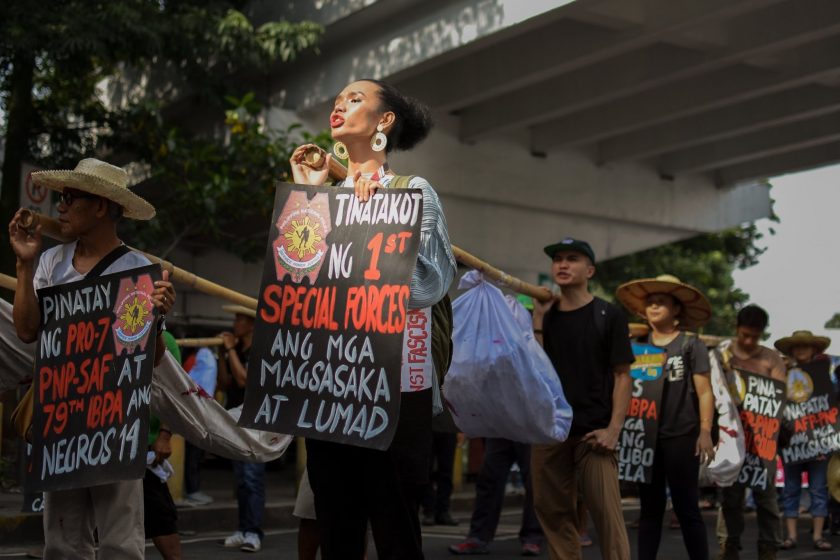The living conditions in the Negros island have been – time and again – a glaring example of government’s failure to implement genuine agrarian reform.
By JANESS ANN J. ELLAO
Bulatlat.com
MANILA – Long before the surge in extra-judicial killings, 65-year-old Delia Isugan has already felt the suffering for one simple reason: She is one of the many landless peasants in the Negros province. And just like the rest wallowing in abject poverty, Isugan struggles to put food on their table.
“A quarter of our produce goes to the landowner, as our ‘rent’ in the one-hectare land we till. The rest is hardly enough to cover our needs,” Isugan told Bulatlat in Filipino, “Pang-kain lang.”
For the past months, the bloodshed in Negros island has struck the country. Toiling farmers, children, and their supporters have been targeted in what appears to be a killing spree – tokhang-style – in the province. Farmers who were killed in the guise of legitimate police operations were accused of “fighting back” (or in police lingo, “nanlaban”).
Human rights group Karapatan referred to the Negros killings as an “orchestrated attack,” attributing them to “various other actors, except for its own state forces who are lurking in communities where killings are rampant.”
Yesterday, Aug. 20, Isugan was among those who marched to Mendiola, seeking justice for her son Jesus. His killing also meant losing their family’s bread-winner, a construction worker earning P250 a day. “He was just a construction worker. He was not an NPA,” she said in tears.
Long-standing struggle for land
The living conditions in the Negros island have been – time and again – a glaring example of the government’s failure to implement genuine agrarian reform. Vast sugar cane plantations remain concentrated in the hands of few elite families.
These landowners – nearly 500 individuals – belonging to local elite families own at least half of the agricultural productions in the region, the Kilusang Magbubukid ng Pilipinas (KMP) said. Data from DAR-Negros Island show that as of September 2016, more than 95,000 hectares have yet to be distributed under land reform.
The landlessness and their dirt-poor salaries have made them one of the poorest regions in the country, with poverty incidence of at least 50.1 percent in 2015. Their sufferings are even worsened during the months of May to September, considered as “tiempo muerto” or dead season, where they resort to doing odd jobs like working as carpenters to get by.
Many of them have resorted to cultivating part of abandoned lands suitable for farming, covering at least a thousand hectares of land. Their efforts, however, have been vilified by state forces. The massacre in Sagay, Negros Occidental on October 20, 2018, which claimed nine lives, highlights the issue of landlessness in the island.
Instead of addressing the poverty and human rights violations in the Negros province, Unyon ng mga Manggagawa sa Agrikultura noted how President Duterte is “hell bent on letting the state security forces to go on a rampage in the Island by employing more troops there and even threatening to put it under martial law.”
Government plans for Negros?

If at all, Isugan said, there had been increased road constructions in her province. This, too, is coupled by the rise of residential and commercial centers.
In fact, there is a proposed P11 billion worth of road network projects that will be poured for Negros Oriental under the Local Road Network Development Plan. This will supposedly promote “economic productivity, trade mobility and accessibility of public services in the province,” according to a Philippine Information Agency report.
These will include road networks that will reportedly connect sectors in various rural industries to spur employment and business opportunities for the people of Negros Oriental.
The Central Visayas Regional Development Plan for 2017 to 2022 states that only Negros Oriental appears to be “affected by insurgency.” As such, the region must sustain its effort to remain “conflict-manageable and development ready.”
Negros Oriental, which accounts for the largest share of land in Central Visayas (about 34.1 percent), was considered as a possible expansion area for a banana plantation. The land in Negros Oriental, according to the Pilipino Banana Growers and Exporters Association in 2015, is suitable for planting cavendish banana.
Business World reported that cavendish banana is considered as a top export, with multi-national companies planting it in over 83,000 hectares in 13 provinces in Mindanao.
KMP Chair Danilo Ramos told Bulatlat that the present administration is planning to expand plantations in Negros. There are also mining companies eyeing the area.
This, he said, is not surprising as they have seen similar patterns in other parts of the country, where struggling farmers are harassed and intimidated to give way to big business interests.
Fighting back
Despite the continuing harassment, Negros farmers and their supporters are determined to turn their grief and mourning into a big fight to end the killings and for justice to be served.
Karapatan’s Reylan Vergara said, “We are enraged as the killings continue, but our resolve remains firm. We call on all sectors to push back and resist against out-right fascism in Negros.”
The post Food as a daily struggle in Negros appeared first on Bulatlat.

